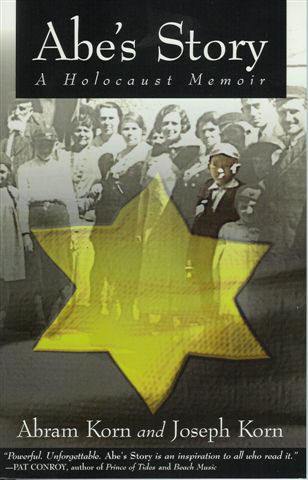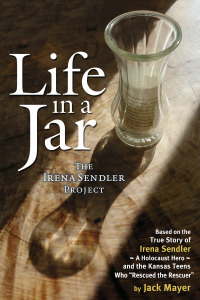 We encourage online learning about Abe's Story.
We encourage online learning about Abe's Story.
Please get in touch if you would like to discuss using Abe's Story in your school or for information on special book prices for classroom sets.
This cross-curricular program was created by Rebecca Crumrine, Jennifer Berger, and Joseph Korn to help teach and learn about the Holocaust using my father's story.
Rebecca teaches at Davidson Fine Arts Magnet School in Augusta, Georgia and Jennifer is working on her Masters Degree in education.
Abe's Story: A Holocaust Memoir by Abram Korn
Introduction
Abe's Story: A Holocaust Memoir is the incredible story of one man's journey through the Holocaust. My father, Abram Korn, was only 16 years old when Hitler's air force, the Luftwaffe, attacked his home town of Lipno, Poland, on the first day of World War II, September 1, 1939. He survived the entire war as a Jewish prisoner, enduring the ghettos, the horrific concentration camps, and the 150-mile Death March from Auschwitz in the middle of the bitterly cold Polish winter. Astoundingly, my father kept his sense of human dignity, helping others to survive while he helped himself. He always believed he could live one more day, and on April 11, 1945, when Buchenwald Concentration Camp was liberated, he was finally free.
Abe's Story continues with the rebuilding of my father's life with several other survivors in post-war Germany, his marriage to Ellie, a German Lutheran who later converted to Judaism, and Dad's emigration to America in 1949. I continue the story in the Epilogue, telling of my mother's delayed emigration, how my parents built a remarkably successful business and proudly raised their family in the Jewish tradition. In the Afterward, I share the emotional story of Dad's last days on earth. I tell how the original manuscript came to be written, and I tell of my involvement in preparing Abe's Story for publication. I also share a remarkable story of an American Liberator who grew to be friends with my parents years later in America.
Dad died in 1972, when I was only 19 years old. I have been speaking in schools and teaching about the Holocaust since 1981. I know how to get students excited and involved. Abe's Story will touch you and your students hearts in unexpected ways. Everyone who reads it seems to apply it in their own lives today. Abe's Story inspires its readers to realize that they can achieve the high goals they set for themselves, despite any obstacles in their path. Reading Abe's Story will change your life.
Purpose
The purpose of this cross-curricular guide is to suggest activities that will help you use Abe's Story more effectively in teaching and understanding about the Holocaust. Abe's Story will help students learn more about the world they live in today by inspiring them to realize the importance of tolerance and acceptance of all people. It stresses ethical and moral values. Just by reading and discussing the story, your students will gain more appreciation for family and for the freedoms and priveleges they have in their lives today. It will help them realize that we all have the potential for good and evil in any circumstances; the choice is ours to make.
Language Arts
- Create an "I Search" that will describe the life of one person in your family, just as Joseph Korn researched his father's life. Use personal interviews of the person and/or of people who know this person.
- If your family doesn't have a family tree, create one by interviewing members of your family, going as far back in your ancestry as possible. If your family does have a family tree, make sure it is up-to-date and learn as much as you can about your ancestors.
- Write a news article based on one chapter in Abe's Story. Remember to pull facts directly from the chapter to include in your article.
- In the Holocaust, the Nazis condemned people to death for no reason other than their religion, their beliefs, or their heritage. Write an essay on prejudice you see in America today and how it affects people's lives.
- Read and discuss a poem about the Holocaust. Then write a response to the poem or create a poem based on Abe's Story or on the Holocaust. (Poems in Cybrary)
- Compare and contrast Abe's Story, a nonfiction account of the Holocaust, to a fictional account that you have read, such as Number the Stars (Lois Lowry) or The Devil's Arithmetic (Jane Yolen).
- Using your knowledge of life in a concentration camp, write a letter from a concentration camp to a family member left in the ghettos, as Abe did while in Camp Hardt.
Social Studies
- Compare a current event to the Holocaust, such as the current situation in the former Yugoslavia, Bosnia-Herzgovenia.
- Using pre- and post-World War II maps, discuss the changes in country boundaries. (Maps in supporting material)
- Show the students Abe's journey throughout the Holocaust using the map found in the introduction of the book or the Interactive Map in the Cybrary. Give students a copy of a map and let each individual plot his/her own map.
- Think about Abe's experience of loss (his dog, his friends, his family, his home, his family's business, his rights as a citizen). Then, in small groups or individually, have students reflect upon losses they have experienced in their own lives. Think about Abe's ability to move on and survive in the face of such loss.
- Compare and contrast the Holocaust to the struggle of other groups, such as Native Americans, African Americans, and Asian Americans. Remember that you can't compare suffering. The purpose here is to consider how other groups of people have been persecuted because of their religion or their heritage.
- Discuss the systematic and intentional loss of identity and self-esteem that Hitler inflicted on the prisoners. How does this lead to the loss of the will to live?
- Define the word "holocaust" using the dictionary? Using the supporting material, define the Holocaust of World War II and discuss how it fits the dictionary definition.
Math
- Using the population size of your town or community, compute how many times the town or community would have to be multiplied to equal the number of innocent people who were murdered in the Holocaust (approximately 12 million.)
- Most people are unable to grasp numbers as large as one million. Have students calculate how long it would take them to count to one million if they counted one number for each second. Inform them that about 12 million innocent people were murdered during the Holocaust, and then ask them to compute how long it would take to count to 12 million. Tell them to imagine that one person is being murdered for each second they count.
- Using the estimated population of various ethnic and religious groups in the United States, calculate the percentage of those groups that would be represented by the 6,000,000 Jews that were murdered in the Holocaust. (Use supporting material.)
- Compute the percentage of the Jewish population of World War II Europe that perished in the Holocaust and then use this percentage to see how many members of the class this would represent.
- Compute the number of days in the war, from the day Germany invaded Poland on September 1, 1939, to the day Germany surrendered, May 8, 1945. How many people were killed outside of combat each day, on an average, if 12 million innocent people were murdered during the Holocaust.
- Using the map of Abe's journey given to students in Social Studies, figure out the distance, in miles and kilometers, between each location in Abe's journey.
Science/Health
- In small groups, have students compile a list of ten things they can do to keep themselves healthy. Using this list, have students examine the possibility of using their knowledge of these ten things to create an unhealthy environment. Explain to students that Hitler used his knowledge of health to deprive prisoners of the essentials of healthy living, thus causing illness and death.
- Discuss different ways that Hitler could create an environment that would promote death? Why would he do this when he could have murdered people more easily and efficiently?
- What is frostbite? What sort of conditions are necessary to cause frostbite and what are its short- and long-term effects? What is gangrene and how does frostbite lead to gangrene? What are the possible short- and long-term effects of gangrene?
- Look up and define cause and symptoms of the disease called Typhus. Discuss the connection between lice infestation and the spread of the disease known as typhus. What conditions create an atmosphere for lice infestation? Discuss how Hitler could purposefully create a typhus epidemic.
- Discuss the number of calories a body needs to sustain an active lifestyle. Have students keep a food journal for a day and calculate the number of calories they consume. Then compare this to the average calories consumed by a prisoner in a concentration camp. (Use supporting material.) Remember to discuss the differences between the amount of calories a student might burn in one day to the amount a prisoner might burn while forced to do hard, physical labor for over half of a day.
- Discuss the footnote on page 54 about how the prisoners were subjected to conditions that caused dysentery. What other diseases could be caused in this manner?
Art
- View photos of Europe and of concentration camps before, during, and after the war and write responses and impressions.
- Read a passage from Abe's Story and illustrate the scene (draw, paint, sculpt, etc.).
- Illustrate an alternative book jacket for Abe's Story .
- Draw a picture of your entire family. Show students the book jacket and explain that Abe was the only survivor of the Holocaust in that picture. Then tell students that two out of every three Jews in Europe were murdered in the Holocaust and have them illustrate this ratio in their own drawings by shading or some other manner.
- Create a diorama of a scene from Abe's Story.
- Illustrate the different colors of triangles on the camp uniforms that signify the different types of people, referring to page 79 in the book. Draw prisoners, identifying them by the different color triangles and the Star of David.
Music/Drama
- Pick a scene and act it out.
- In the section of Abe's Story about Auschwitz, Abe discusses the use of music in the camps. Why would Hitler desire that music be performed in the death camps?
- Watch and discuss the Prejudice and Hate video available in your media center (Georgia Public Schools only).
- Learn Hatikva, the Jewish Song of Hope, including the Hebrew phonetic and English translations. (Words and music to be included)
- Hitler viewed Germany as the cultural center of Europe, if not the world. How could he have used that to incite prejudice?
We encourage online learning about Abe's Story.
This preliminary cross-curricular guide is currently being formalized into five- and ten-day lesson plans.
Significant discounts are available for quantity orders. I hope you will choose to order your own copy of Abe's Story today.
Joey Korn's web sites



